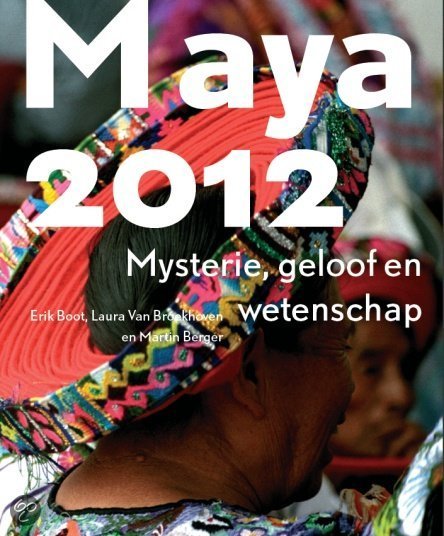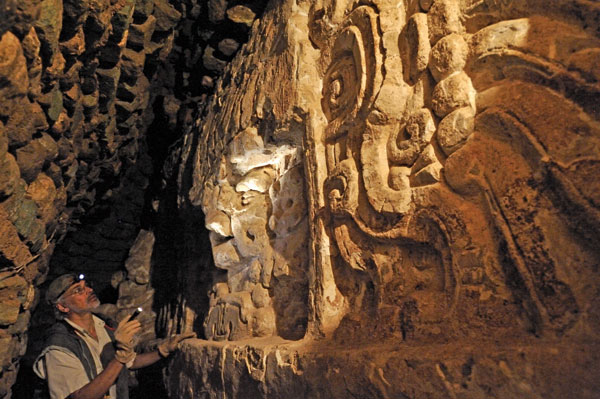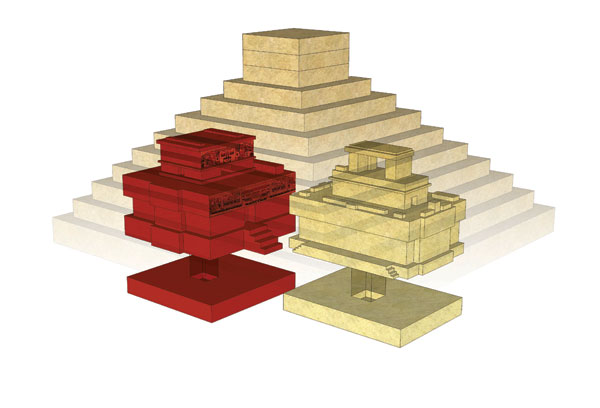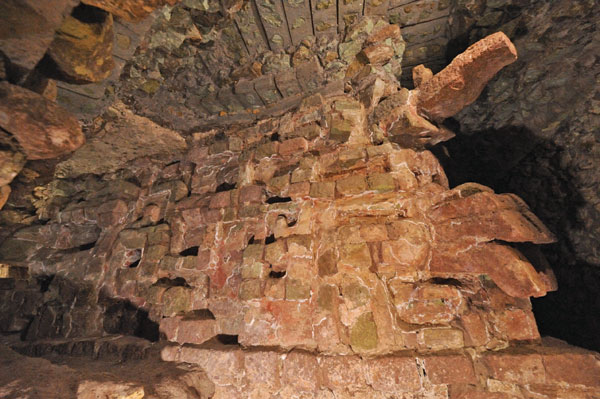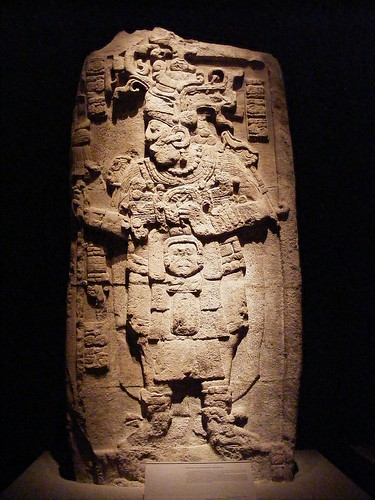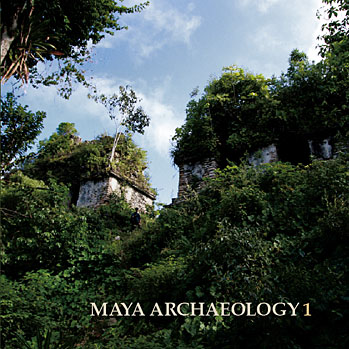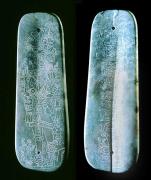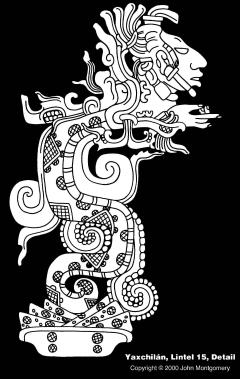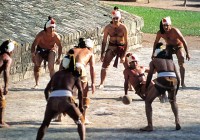
Maya News Updates 2009, No. 37: Leiden, Netherlands - Exhibition "Maya 2012" Opened to the Public
On October 7, 2009, the exhibition "Maya 2012, het mysterie van een eeuwenoud volk" (Maya 2012, the mystery of a centuries old people) at the Museum of Ethnology in Leiden, the Netherlands, was presented to an invited audience and the press. On October 9, 2009, the exhibition was opened to the general public.
The exhibition is centered around the theme of the well-known date 13.0.0.0.0, 4 Ajaaw 3 Uniiw, a date which through the correlation constant 584,283 can be transposed to the Christian (Gregorian) date December 21, 2012. And that date has become of importance in recent years, in which many a "doomsday" scenario has been described. Not so at this exhibition, which targets a young audience of 8 to 15 years, accompanied by their elder brothers and sisters, their parents, and grand parents. This exhibition, simply said, invites the family.
On a relatively small surface the exhibition shows Precolumbian and present-day objects from the Maya area, all part of the museum collection. The exhibition has a thematic approach and through different themes it introduces the visitors to different aspects of Maya life and culture, for instance Life and Death, Kingship, and the Ballgame. The exhibition is interactive and especially for this exhibition a Dutch software company has developed a "Maya ballgame" application in which the participants (one to one) will wear a protective belt and an arm protector (like the ancient Maya ballplayers). The ballcourt setting ... the Great Ballcourt at Chichen Itza.
Touch screen monitors are placed strategically throughout the exhibition, providing more in-depth information on the different subjects. The Precolumbian Maya objects are exhibited in special show cases and all can be walked around to see the object in full detail. Each show case carries a number through which the explanatory text can be found in the accompanying large, fold-out flyer. Several glyphic texts of some of the Maya vases have been drawn for this occasion and have been integrated into the flyer (the drawings are mine, as I have worked as a consultant during the preparations of this exhibition).
Parts of the exhibition that particularly draw the attention are the Maya sky at night in which the ancient "Maya constellations" are portrayed through a fluid computer animated presentation, the close to life-size reconstruction of the inside of Structure 1, Room 2, at Bonampak (with the reconstructed mural paintings by Heather Hurst beautifully printed on canvas), the position of La Pasadita, Lintel 2, accompanied by an animated and colored wall projection and auditory explanation explaining the contents of both iconography and written text, and the show case presenting the famous Leiden Plate. This corner of the exhibit connects with a basic explanation of the Maya calendar and calculus. The the king's portrait on Leiden Plaque has been painted on the back wall, accompanied by a "sectioned and colored copy". Each section (parts of the headdress, wristlets, anklets, belt, etc.) can be lifted from the king's portrait and the back provides the explanatory text what part of the king's costume it is.
The final part of the exhibition shows the one Classic Maya text (through an enlarged black-and-white drawing) that records the date 13.0.0.0.0, 4 Ajaaw 3 Uniiw in 2012 (with as caveat, if our current understanding of the correlation between the two calendars is correct of course). And here I will add more detail and my personal opinion on the text (my opinion and knowledge is based on personal research on Maya culture in general and Maya epigraphy in particular for many years as well as conversations and email exchanges with many Mayanists on the subject of this text as well as related subjects; at the 2005 European Maya Conference in Geneva, Switserland, I hosted a workshop on the subject). This text is the final part of a longer inscription (known as Monument 6, possibly a T-shaped wall panel) from the site of Tortuguero, located in the Mexican state of Tabasco. During its apogee in the Late Classic, the time period in which this text was produced (the main text records historical dates and events from A.D. 612 to A.D. 667; the side panel records a date in A.D. 510, after which a Distance Number follows to connect the event to A.D. 2012), the site had a strong connection with the site of Palenque (both royal houses employ the same paramount title), located in the Mexican state of Chiapas. To me this is of great importance when we consider the putative 2012 date at Tortuguero. Several texts at Palenque, written during the reigns of various kings, refer to another 13.0.0.0.0 date, the one on 4 Ajaaw 8 Oohl, or August 11, 3114 B.C. (same correlation, 584,283; Gregorian). The Maya scribes, as instructed by their royal patrons, recorded the mythical events before, on, and after that very early date. From these events, and the mythological participants in these events, the Palenque kings derived their royal legitimacy. However, these events concerning 4 Ajaaw 8 Oohl are only covered in short, summary statements, the precise meaning of some of these events still eludes us or are hieroglyphically transparent (we can decipher all glyphic parts) but in meaning it remains opaque (the resulting word has many meanings which may be applicable, or the word does not exist anymore). These particular texts, written and inscribed under the patronage of Palenque kings K'inich Kan Balam and K'inich Ahkuul Mo' Naahb' III, most intriguingly open with these events relative to 13.0.0.0.0, 4 Ajaaw 8 Oohl, in 3114 B.C.
The Tortuguero monument seems to do something comparable. The final part on the 2012 (actually 13.0.0.0.0) date is very short, just 8 glyph blocks describe the date and the events that are related to this date. The much longer preceeding text (most probably when the monument was in one piece and T-shaped) covers over 175 glyph blocks detailing important events in the life of Tortuguero kings. Thus less than 10% of the text tells us, in the present-day, about 13.0.0.0.0, 4 Ajaaw 3 K'ank'in in 2012. If it was a wall panel, it would have been placed in a private setting and the contents of the text was not meant for eyes at all ... More importantly, the 13.0.0.0.0, 4 Ajaaw 3 Uniiw, in 2012, date and events are recorded AT THE END of the text.
Where at Palenque the texts OPEN with events before, on, or just after 13.0.0.0.0, 4 Ajaaw 8 Oohl in 3114 B.C., the text at Tortuguero CLOSES with the events on 13.0.0.0.0, 4 Ajaaw 3 K'ank'in in 2012. The integration of these very important dates, calendrically but also mythologically, seems to be some kind of literary device. "From the olden times" (Palenque) to the "new times" (Tortuguero); these dates thus frame HISTORICAL events (the dates and events "in the middle") and the kings that employ these dates, and record the associated events and the names of the mythological participants, derive their legitimacy from them.
So, what does that final event, in 2012, recorded at Tortuguero actually tell us? First of all, and very importantly, this part of the text suffers from erosion and breakage. This breakage even has resulted in the fact that parts of this text are housed at different locations in the world; part in a museum in Villahermosa, Mexico (where it is on exhibit), while another part resides in the USA in a private collection (luckily, there are photos ... and no, I have not seen the fragment). But .... the final part of the text tells us that 13 calendrical periods named pik (aka. bak'tun) are completed on the date 4 Ajaaw 3 Uniiw. On this date something will happen ('u-to-ma, for utoom), somewhere ... but the name of the possible location is eroded (and epigraphers do not even agree if indeed this is the name of a location or that it spells something completely different). The text continues with what seems to be a spelling ye-ma, but which for the same calligraphic reasons (long inner lines and rotation of the sign; and considering erosion) may read ye-he (possibly a former je sign; at the end of the Classic period /j/ and /h/ merged). Both lead to viable readings, ye-ma to yemal "(is the) descent of" and ye-he to yehet/yeht perhaps meaning "together with" (research on the meaning of -eht continues, as does research on the root em-). What follows this statement is the name of a god, Balun Yokte'; in other texts his name is recorded in full as Balun Yokte' K'uh, in which k'uh means "god" (and we now can enter a debate if the "god-concept" among the first Spanish frairs, who composed the earliest dictionaries in the 16th century, is the same as the "god-concept" among the Maya, or Mesoamerica for that matter).
So, what does that final event, in 2012, recorded at Tortuguero actually tell us? First of all, and very importantly, this part of the text suffers from erosion and breakage. This breakage even has resulted in the fact that parts of this text are housed at different locations in the world; part in a museum in Villahermosa, Mexico (where it is on exhibit), while another part resides in the USA in a private collection (luckily, there are photos ... and no, I have not seen the fragment). But .... the final part of the text tells us that 13 calendrical periods named pik (aka. bak'tun) are completed on the date 4 Ajaaw 3 Uniiw. On this date something will happen ('u-to-ma, for utoom), somewhere ... but the name of the possible location is eroded (and epigraphers do not even agree if indeed this is the name of a location or that it spells something completely different). The text continues with what seems to be a spelling ye-ma, but which for the same calligraphic reasons (long inner lines and rotation of the sign; and considering erosion) may read ye-he (possibly a former je sign; at the end of the Classic period /j/ and /h/ merged). Both lead to viable readings, ye-ma to yemal "(is the) descent of" and ye-he to yehet/yeht perhaps meaning "together with" (research on the meaning of -eht continues, as does research on the root em-). What follows this statement is the name of a god, Balun Yokte'; in other texts his name is recorded in full as Balun Yokte' K'uh, in which k'uh means "god" (and we now can enter a debate if the "god-concept" among the first Spanish frairs, who composed the earliest dictionaries in the 16th century, is the same as the "god-concept" among the Maya, or Mesoamerica for that matter).
Epigraphic research has shown that Balun Yokte' K'uh is a god (...) who is connected to war and the transition of time periods. One text at Palenque even connects this god to an important mythological (read "not historical", although now we can enter yet another debate) event some 900,000 years in the past. The final glyph block opens with the sign ta, probably spelling the preposition ta "in, for, with," but what follows, the very last glyphic signs, nearly is eroded beyond recognition. Only a few inner lines remain, even the outher cartouches are incomplete.
The "prophecy" of 2012, that one Classic Maya text on the date 13.0.0.0.0, 4 Ajaaw 3 Uniiw, is incomplete. We have just sniblets on this date and its associated events. Not even story can be recorded in 8 glyph blocks, maybe just the main words of a much longer headline that recalls the story of what will happen on that date. Just as we have only fragmentary (but still more than ...) information on that other date in Maya time reckoning, 13.0.0.0.0, 4 Ajaaw 8 Oohl, in 3114 B.C.
So, what happens after? Well, it all continues. Even the Maya told us. For instance, at Palenque king K'inich Janaahb Pakal records a date into the future and well after 2012. And with excavations going on in the Maya area most probably the next discovery brings us a new text and yet another pespective on these events described above, or any other event for that matter. We are learning, and we keep learning. As 13.0.0.0.0, 4 Ajaaw 3 Uniiw, is not the end of the Maya calendar or Maya culture or the world as we know it, let this date and its fascinating circumstances not be the end of our learning, understanding, ansd appreciation.
The "prophecy" of 2012, that one Classic Maya text on the date 13.0.0.0.0, 4 Ajaaw 3 Uniiw, is incomplete. We have just sniblets on this date and its associated events. Not even story can be recorded in 8 glyph blocks, maybe just the main words of a much longer headline that recalls the story of what will happen on that date. Just as we have only fragmentary (but still more than ...) information on that other date in Maya time reckoning, 13.0.0.0.0, 4 Ajaaw 8 Oohl, in 3114 B.C.
So, what happens after? Well, it all continues. Even the Maya told us. For instance, at Palenque king K'inich Janaahb Pakal records a date into the future and well after 2012. And with excavations going on in the Maya area most probably the next discovery brings us a new text and yet another pespective on these events described above, or any other event for that matter. We are learning, and we keep learning. As 13.0.0.0.0, 4 Ajaaw 3 Uniiw, is not the end of the Maya calendar or Maya culture or the world as we know it, let this date and its fascinating circumstances not be the end of our learning, understanding, ansd appreciation.
Now go see this exhibition! ;) And there is not only an exhibition, it is accompanied by a website and a television series (an adventure-detective story, televized in 12 episodes by the AVRO). But the exhibition is in Dutch ... well, yes, and no. All important explanatory texts are in English as well.
Learning about 2012 is one in this exhibit, getting to know the Museum of Ethnology's Maya collection is two, and experiencing this exhibit and its interactive showcasing is three. Three, yet another magic number. But that is a different story ...
Below (the) Dutch readers/readers of Dutch can find the review of the exhibit as was published today, October 13, 2009, in the Dutch daily newspaper De Telegraaf.
Learning about 2012 is one in this exhibit, getting to know the Museum of Ethnology's Maya collection is two, and experiencing this exhibit and its interactive showcasing is three. Three, yet another magic number. But that is a different story ...
Below (the) Dutch readers/readers of Dutch can find the review of the exhibit as was published today, October 13, 2009, in the Dutch daily newspaper De Telegraaf.




